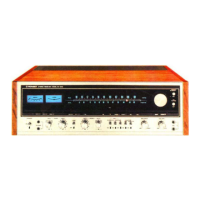CIRCUIT DESCRIPTION
SIGNAL PATH
1. The FM broadcast
signal waveform from the
antenna is fed to the two dual-
gate MOS
field-effect transistors in the front end
for
radio frequency amplification. This
signal is
converted into an intermediate frequency by
the dual-
gate MOS FET mixer stage in com-
bination with the
signal from the local oscil-
lator.
2. The
intermediate frequency signal
, con-
verted within the front end
, is fed to four
ceramic filters and three ICs
, where it is
tuned
, amplified
, and detected
, becoming a
audio frequency (composite) signal.
The composite
signal following detection is
fed to the 4 CH MPX terminal jack
and the
multiplex decoder stage.
3. The multiplex decoder stage
uses one IC for
three functions: to
demodulate the com-
posite signal into the left and right
channel
stereo signals
, to operate the automatic
mode switching between stereo/mono
, and
to switch the
stereo indicator lamp appro-
priately.
The decoding system uses a phase locked
loop (PLL) circuit
, which assures continuous
stable operation and excellent
stereo sepa-
ration with low
susceptibility to external
noise (such as
car
ignition noise) and
ambient temperature changes.
After decoding, the
signal is fed to four
transistors and one LC filter
, where the
residual carrier component (38kHz
, 19kHz
and SCA) is rejected
, and then to the audio
amplifier section.
4. The FM muting circuit consists effectively of
two circuits, designed to reduce the pulse
noise which can so
easily arise
when a
muting circuit is operative.
The one circuit is an
electronic switch in-
corporated into the IC
, so that the de-
modulated circuit is
switched off and on in
the IC
, and the other short-
circuits the audio
signal by means of a reed relay.
5. The AM tuner section
employs one mono-
lithic IC which functions as radio frequency
amplifier
, frequency converter
, local oscil-
lator
, intermediate frequency amplifier
, and
detector. The output is a pure
audio signal.
6. The signals which are applied to the MIC and
PHONO terminal jacks are selected by the
FUNCTION switch before being fed to the
first stage of the three-
stage differential
direct-coupled equalizer amplifier by which
the signals are amplified.
In order to reduce the
switch noise
, the
circuit configuration employed enables the
potential at the input and output terminals
to be set at near zero volts.
SX-
1 01 0
It incorporates an independent differential
circuit in the first stage of the
equalizer
amplifier whose DC supply uses twin plus
and minus.
7. The output from the equalizer amplifier
together with that from the
AUX terminal
jacks, the audio
signal from the AM tuner
and the audio signal from the FM tuner
, are
all selected by the FUNCTION switch
, and
pass through the switch circuits for TAPE
DUPLICATE
, TAPE MONITOR, 4 CH
ADAPTOR DOLBY NR ADAPTOR
, and
the circuits for BALANCE and VOLUME
controls, before being fed to the control
amplifier.
8. The control amplifier has an extremely high
input impedance
, using PNP and NPN tran-
sistors in a
direct-coupled two-stage circuit.
This greatly reduces the influence of the
performance inherent in equipment
con-
nected externally.
The output from this two-
stage direct-
coupled circuit is
divided into two circuit
systems.
One goes to the TONE switch via the twin
tone control circuit, and the other goes
directly and unmodified in any way
.to the
TONE
switch. The TONE switch selects
between them.
9. The amplifier section of the twin control has
closed loop NFB
amplifiers for both the
main and sub circuits
, each of which has its
own transistor
, eliminating mutual inter-
ference.
10. The control amplifier output is fed to the
power amplifier after
passing through the
LOW FILTER, HIGH FILTER and AUDIO
MUTING circuits.
The first stage of the power amplifier is a
differential amplifier element with constant
current load , and the second stage
, too, uses
a differential amplifier element, so that DC
potential drift is prevented.
On the other hand, the final output stage
uses two power transistors in parallel in both
the upper and lower circuits
, so that large
collector dissipation is possible.
Again, in order to reduce the
distortion
which occurs at low
signal levels, the idle
current has been set at a standard
level of
100mA.
11. The power amplifier output is fed to
the
three push
buttons which form
the
SPEAKER switch. This selects A
, B
, and C
speaker system terminal connection.
If all three speaker systems were to
connected
simultaneously, the
effective
speaker impedance might be less than 4il.
To guard
against this possibility, when all
three buttons are
depressed together
, all
three systems are
disconnected from the
amplifier.
12. The power amplifier circuit board includes a

